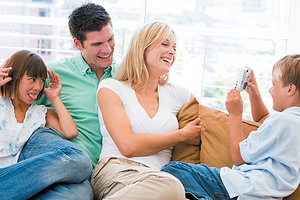These days, many parents childproof their homes before a baby is even mobile. You will see an array of electrical outlet covers, bumpers on the corners of the coffee table and safety latches on the cupboards.
Furniture Safety
A recent study published online in the journal Pediatrics suggests an alarming increase in the rate of children being injured by falling TVs. Since newer TVs are typically flat-panel and placed in the living room, this has led to the older, heavier television sets being relegated to bedrooms and placed on top of dressers. In some cases, the child may use the drawers to climb up to try to access the TV, which may topple the dresser, the television or both.1
In just the past 20 years, the number of children injured by falling televisions has doubled; in that same time period, more than 200 children have been killed. This is unacceptable, particularly since the dangers can be so easily avoided.
With regards to flat-panel TVs, if there are young children in the home, TVs should be mounted on the wall or to a television stand designed to support that particular weight and model. Larger, older television sets should be positioned only on low-lying television stands that are wider on both sides than the TV. This allows for more stability.2
 If parents are going to put a TV on top of a dresser, make sure they know the dresser should be wider than the television to add some stability. They should place the TV back against the wall, allowing for space in front of the TV. In this instance, the TV will need to be pulled forward before it can be pulled down. While not an ideal situation, it is at least somewhat safer.
If parents are going to put a TV on top of a dresser, make sure they know the dresser should be wider than the television to add some stability. They should place the TV back against the wall, allowing for space in front of the TV. In this instance, the TV will need to be pulled forward before it can be pulled down. While not an ideal situation, it is at least somewhat safer.
Speaking of dressers, they can also be "childproofed" by installing stops on the drawers to prevent them from being pulled all the way out. If more than one or two drawers are opened all the way, the weight from the drawers can throw off the balance, causing the dresser to topple over (on top of the child). To stop the dresser from going over, safety brackets are the best solution. The bracket should be screwed into the wall in a wall stud, and then screwed into either the back or top of the dresser.
Bookshelves also should be attached to the wall with safety brackets. Young children are climbers; attaching the shelving unit to the wall will remove the risk that it may fall over on top of them if they do choose to scale it.3
Electrical Safety
It is estimated that at least seven children will be seen in an emergency room each day due to an electrical-related injury.4 Several precautions can be taken to minimize this danger. First, have parents inspect for any cords that are in reach of their children. Look for any frayed or loose wires; these should be replaced immediately. No cords should be running under carpets or across doorways, as it increases the risk of a child tripping and the added risk of the appliance being pulled over by the cord being jerked.5
Second, families should consider hiring an electrician to add more outlets before using extension cords. Replacing extension cords with outlets will avoid a potential twofold threat: the risk of the child tripping over the cord and the possibility of overloading an outlet.
Plumbing Safety
Unfortunately, we don't typically think about how hot the water coming out of the faucet is until something happens and a child is seriously burned or scalded. This can be easily avoided by having a plumber install an anti-scald device for the faucets and showerhead. This can regulate the water temperature and avoid the risk of burns.5 Additionally, most hot-water heaters have a temperature regulator built in; advise parents to ensure it's set at no higher than 120 degrees.
Kitchen Safety
In an ideal world, little ones would not be permitted in the kitchen; but that's just not realistic. Therefore, to keep them protected, it's important to consider the following safety measures:5
- Install a safety cover on the garbage disposal to protect wondering hands.
- Make sure all small appliances are unplugged when not in use.
- Store garbage cans in a cabinet with a latch to avoid children ingesting something dangerous or even poisonous.
For children who are a little older, it's important to educate them about what to do if something should happen in the kitchen. For instance, keep a box of baking soda near the stove and make sure the child knows where to find it and how to use it to put out a fire. A lid can also be kept nearby to place over a skillet and smother a grease fire.2
Additionally, it's not unusual to have a fire extinguisher in the kitchen, but it will be less than useless if no one knows how to use it. Make sure to review the instructions with anyone in the home who will be cooking or baking in the kitchen.
Fire Safety
Speaking of fire safety, while most fires do start in the kitchen, it's still wise to have fire extinguishers placed strategically throughout the house. For multi-story homes, be sure to place an extinguisher on each floor.6
Create an escape plan with at least two routes in case of a fire and practice at least twice a year. It would be beneficial to practice this plan at least once after dark. Be sure that every member of the family knows where to go, what to do and how to do it. Visit the National Fire Protection Association's website for suggestions.7
First Aid
No matter how hard parents try to keep their family safe, there's always a possibility someone may get injured. Instruct parents to have the best remedies for each situation on hand.
Every home should have an aloe vera plant. This is not only the No. 1 comfort for sunburns (or any other type of burn, for that matter), but it's also a powerful anti-inflammatory, a natural analgesic, and able to speed up cell growth due to the large number of nutrients, vitamins, amino acids and fatty acids it contains.8
Arnica is a natural cream or oral remedy for pain. Applied to the skin directly, it can soothe aching muscles, help reduce inflammation and even heal wounds. Although commonly used for sprains and bruises, it can also be taken orally in diluted doses as an herbal pain reliever.9
Another valuable first-aid recommendation for families is the RICE protocol (Rest, Ice, Compression and Elevation) for sprains, strains and bruises:
- Rest – always rest after an injury and avoid all activity that will cause pain.
- Ice – apply an ice pack to the injured area for 20 minutes every 2-3 hours.
- Compression – for visible swelling, elastic bandages work well, but avoid bandages that are too tight.
- Elevation – elevate the injured area above heart level using a pillow or chair.
The Chiropractic Factor
As family wellness chiropractors, we have a wonderful opportunity to be resource sharers in our practices, and this includes helping parents to protect their children. You can even teach a "Living Safely" workshop for your parents and share safety ideas that are commonly overlooked.
References
- De Roo AC, et al. Television-related injuries to children in the United States, 1990-2011. Pediatrics, published online July 22, 2013.
- Preventing Injuries in Children: Safety Tips. SafeKids.org.
- Furniture Tip-Overs: Facts, Causes and Prevention Tips. Child Injury Prevention Alliance.
- Consumer Product Safety Commission (CPSC) 10-year study of electrical-related injuries (1991-2000); National Electronic Injury Surveillance Systems (NEISS) data.
- Home & Organizing: Easy Cleaning and Home Organizing Tips. Realsimple.com.
- "Enhance Your Home Fire Safety." Ohio State University Office of Student Life, Neighborhood Services and Collaboration.
- National Fire Protection Association: Safety Information.
- Surjushe A, et al. A short review of aloe vera. Indian J Dermatol, 2008;53(4):163-66.
- Arnica: Overview, Uses and Precautions. University of Maryland Medical Center.
Click here for previous articles by Claudia Anrig, DC.





